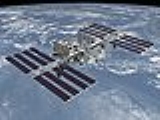
Assembly of the International Space Station
Encyclopedia
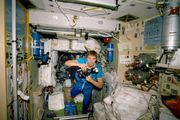
International Space Station
The International Space Station is a habitable, artificial satellite in low Earth orbit. The ISS follows the Salyut, Almaz, Cosmos, Skylab, and Mir space stations, as the 11th space station launched, not including the Genesis I and II prototypes...
is a major aerospace engineering endeavour being conducted in Low Earth orbit
Low Earth orbit
A low Earth orbit is generally defined as an orbit within the locus extending from the Earth’s surface up to an altitude of 2,000 km...
by a consortium
Consortium
A consortium is an association of two or more individuals, companies, organizations or governments with the objective of participating in a common activity or pooling their resources for achieving a common goal....
of government
Government
Government refers to the legislators, administrators, and arbitrators in the administrative bureaucracy who control a state at a given time, and to the system of government by which they are organized...
al and inter-governmental space agencies.
Zarya
Zarya
Zarya , also known as the Functional Cargo Block or FGB , was the first module of the International Space Station to be launched. The FGB provided electrical power, storage, propulsion, and guidance to the ISS during the initial stage of assembly...
, the first ISS module, was launched by a Proton rocket on 20 November 1998. The STS-88
STS-88
-Mission parameters:*Weight*Liftoff: *Landing: *Perigee: *Apogee: *Orbital Period: 92.4min-Launch attempts:-Mission highlights:Node 1, named Unity, was the first space station hardware delivered by the space shuttle. It has two Pressurized Mating Adapters , one attached to either end...
shuttle mission followed two weeks after Zarya was launched, bringing Unity
Unity Module
thumb|right|300px|ISS Unity connecting module The Unity connecting module was the first U.S.-built component of the International Space Station....
, the first of three node modules, and connecting it to Zarya. This bare 2-module core of the ISS remained unmanned for the next one and a half years, until in July 2000 the Russian module Zvezda was added, allowing a minimum crew of two astronauts or cosmonauts to be on the ISS permanently.
When assembly is complete, the ISS will have a pressurized volume of approximately 1,000 cubic meters, a mass of approximately 400,000 kilograms, approximately 100 kilowatts of power output, a truss 108.4 meters long, modules 74 meters long, and a crew of six. Building the complete station will require more than 40 assembly flights. As of March 2011, 26 Space Shuttle flights have docked with ISS to add elements, and 9 other Shuttle flights have flown logistics-servicing missions to ISS without adding major external elements. These 35 Shuttle missions include 9 SpaceHab
SPACEHAB
Astrotech Corporation , formerly Spacehab Inc., is an aerospace company headquartered in Austin, Texas which provides commercial space products and services to NASA, the U.S. Department of Defense, international space agencies, and global commercial customers...
and 10 MPLM logistics-servicing missions in various combinations. The last two planned Shuttle flights are due to add one of the two final elements of ISS, followed by one last Proton launch with the planned delivery of the ERA
European Robotic Arm
The European Robotic Arm is a robotic arm to be attached to the Russian Segment of the International Space Station. It will be the first robot arm able to work on the Russian space station segments, and will supplement the two Russian Strela cargo cranes that are already installed on the Pirs...
. Other assembly flights have consisted of modules lifted by the Russian Proton rocket or in the case of Pirs and Poisk by a Soyuz-U
Soyuz-U
The Soyuz-U launch vehicle is an improved version of the original Soyuz LV. Soyuz-U is part of the R-7 family of rockets based on the R-7 Semyorka missile. Members of this rocket family were designed by the TsSKB design bureau and constructed at the Progress Factory in Samara, Russia....
rocket.
Logistics
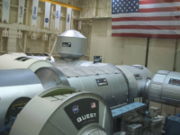
Space station
A space station is a spacecraft capable of supporting a crew which is designed to remain in space for an extended period of time, and to which other spacecraft can dock. A space station is distinguished from other spacecraft used for human spaceflight by its lack of major propulsion or landing...
is located in orbit
Orbit
In physics, an orbit is the gravitationally curved path of an object around a point in space, for example the orbit of a planet around the center of a star system, such as the Solar System...
around the Earth
Earth
Earth is the third planet from the Sun, and the densest and fifth-largest of the eight planets in the Solar System. It is also the largest of the Solar System's four terrestrial planets...
at an altitude of approximately 360 km (223.7 mi), a type of orbit usually termed low Earth orbit
Low Earth orbit
A low Earth orbit is generally defined as an orbit within the locus extending from the Earth’s surface up to an altitude of 2,000 km...
(the actual height varies over time by several kilometers due to atmospheric drag and reboost
Reboost
Reboost is the process of boosting the altitude of an artificial satellite, to increase the time until its orbit will decay and it re-enters the atmosphere...
s). It orbits Earth in a period
Orbital period
The orbital period is the time taken for a given object to make one complete orbit about another object.When mentioned without further qualification in astronomy this refers to the sidereal period of an astronomical object, which is calculated with respect to the stars.There are several kinds of...
of about 90 minutes; by August 2007 it had completed more than 50,000 orbits since launch of Zarya on 20 November 1998.
A total of 14 main pressurized modules are scheduled to be part of the ISS by its completion date in 2010. A number of smaller pressurized sections will be adjunct to them (Soyuz spacecraft
Soyuz spacecraft
Soyuz , Union) is a series of spacecraft initially designed for the Soviet space programme by the Korolyov Design Bureau in the 1960s, and still in service today...
(permanently 2 as lifeboats - 6 months rotations), Progress
Progress spacecraft
The Progress is a Russian expendable freighter spacecraft. The spacecraft is an unmanned resupply spacecraft during its flight but upon docking with a space station, it allows astronauts inside, hence it is classified manned by the manufacturer. It was derived from the Soyuz spacecraft, and is...
transporters (2 or more), the Quest and Pirs airlocks, as well as periodically the Multi-Purpose Logistics Module
Multi-Purpose Logistics Module
A Multi-Purpose Logistics Module is a large pressurized container used on Space Shuttle missions to transfer cargo to and from the International Space Station . An MPLM was carried in the cargo bay of a Shuttle and berthed to the Unity or Harmony modules on the ISS. From there, supplies were...
, the Automated Transfer Vehicle
Automated Transfer Vehicle
The Automated Transfer Vehicle or ATV is an expendable, unmanned resupply spacecraft developed by the European Space Agency . ATVs are designed to supply the International Space Station with propellant, water, air, payload and experiments...
and the H-II Transfer Vehicle
H-II Transfer Vehicle
The H-II Transfer Vehicle , called , is an unmanned resupply spacecraft used to resupply the Kibō Japanese Experiment Module and the International Space Station . The Japan Aerospace Exploration Agency has been working on the design since the early 1990s. The first mission, HTV-1, was originally...
).
The ISS, when completed, will consist of a set of communicating pressurized modules connected to a truss
Integrated Truss Structure
the Integrated Truss Structure forms the backbone of the International Space Station, with mountings for unpressurized logistics carriers, radiators, solar arrays, and other equipment.-History:...
, on which four large pairs of photovoltaic modules (solar panels) are attached. The pressurized modules and the truss will be perpendicular: the truss spanning from starboard to port and the habitable zone extending on the aft
Aft
Aft, in naval terminology, is an adjective or adverb meaning, towards the stern of the ship, when the frame of reference is within the ship. Example: "Able Seaman Smith; lay aft!". Or; "What's happening aft?"...
-forward axis. Although during the construction the station attitude may vary, when all four photovoltaic modules are in their definitive position the aft-forward axis will be parallel to the velocity vector.
In addition to the assembly and utilization flights, approximately 30 Progress spacecraft flights are required to provide logistics until 2010. Experimental equipment, fuel and consumables are and will be delivered by all vehicles visiting the ISS: the Shuttle, the Russian Progress, the European ATV
Automated Transfer Vehicle
The Automated Transfer Vehicle or ATV is an expendable, unmanned resupply spacecraft developed by the European Space Agency . ATVs are designed to supply the International Space Station with propellant, water, air, payload and experiments...
and the Japanese HTV
H-II Transfer Vehicle
The H-II Transfer Vehicle , called , is an unmanned resupply spacecraft used to resupply the Kibō Japanese Experiment Module and the International Space Station . The Japan Aerospace Exploration Agency has been working on the design since the early 1990s. The first mission, HTV-1, was originally...
.
Columbia disaster and changes in construction plans

Disaster and consequences
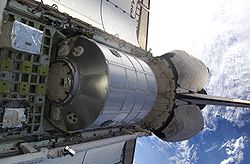
Space Shuttle Columbia disaster
The Space Shuttle Columbia disaster occurred on February 1, 2003, when shortly before it was scheduled to conclude its 28th mission, STS-107, the Space Shuttle Columbia disintegrated over Texas and Louisiana during re-entry into the Earth's atmosphere, resulting in the death of all seven crew members...
on 1 February 2003, the subsequent two and a half year suspension of the U.S. Space Shuttle program
Space Shuttle program
NASA's Space Shuttle program, officially called Space Transportation System , was the United States government's manned launch vehicle program from 1981 to 2011...
, followed by problems with resuming flight operations in 2005, were major obstacles.
The Space Shuttle program resumed flight on 26 July 2005, with the STS-114
STS-114
-Original crew:This mission was to carry the Expedition 7 crew to the ISS and bring home the Expedition 6 crew. The original crew was to be:-Mission highlights:...
mission of Discovery
Space Shuttle Discovery
Space Shuttle Discovery is one of the retired orbiters of the Space Shuttle program of NASA, the space agency of the United States, and was operational from its maiden flight, STS-41-D on August 30, 1984, until its final landing during STS-133 on March 9, 2011...
. This mission to the ISS was intended both to test new safety measures implemented since the Columbia disaster, and to deliver supplies to the station. Although the mission succeeded safely, it was not without risk; foam was shed by the external tank
Space Shuttle external tank
A Space Shuttle External Tank is the component of the Space Shuttle launch vehicle that contains the liquid hydrogen fuel and liquid oxygen oxidizer. During lift-off and ascent it supplies the fuel and oxidizer under pressure to the three Space Shuttle Main Engines in the orbiter...
, leading NASA to announce future missions would be grounded until this issue was resolved.
Between the Columbia disaster and the resumption of Shuttle launches, crew exchanges were carried out solely using the Russian Soyuz spacecraft
Soyuz spacecraft
Soyuz , Union) is a series of spacecraft initially designed for the Soviet space programme by the Korolyov Design Bureau in the 1960s, and still in service today...
. Starting with Expedition 7
Expedition 7
Expedition 7 was the seventh expedition to the International Space Station.-Crew:-Mission parameters:*Perigee: 384 km*Apogee: 396 km*Inclination: 51.6°*Period: 92 min...
, two-astronaut caretaker crews were launched in contrast to the previously launched crews of three. Because the ISS had not been visited by a shuttle for an extended period, a larger than planned amount of waste accumulated, temporarily hindering station operations in 2004. However Progress transports and the STS-114
STS-114
-Original crew:This mission was to carry the Expedition 7 crew to the ISS and bring home the Expedition 6 crew. The original crew was to be:-Mission highlights:...
shuttle flight took care of this problem.
Changes in construction plans
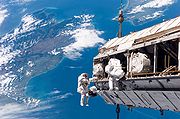
Space Shuttle Columbia disaster
The Space Shuttle Columbia disaster occurred on February 1, 2003, when shortly before it was scheduled to conclude its 28th mission, STS-107, the Space Shuttle Columbia disintegrated over Texas and Louisiana during re-entry into the Earth's atmosphere, resulting in the death of all seven crew members...
in early 2003 (although there had been prior delays due partly to Shuttle problems, and partly to delays stemming from the Russian space agency's budget constraints). During the shuttle stand-down, construction of the ISS was halted and the science conducted aboard was limited due to the crew size of two.
As of the beginning of 2006, many changes were made to the originally planned ISS, even before the Columbia disaster. Modules and other structures were cancelled or replaced and the number of Shuttle flights to the ISS was reduced from previously planned numbers. However more than 80% of the hardware intended to be part of the ISS in the late 1990s was orbited and is part of the ISS's ultimate configuration.
In March 2006, a meeting of the heads of the five participating space agencies accepted the new ISS construction schedule that plans to complete the ISS by 2010. A crew of six has been established as of May 2009, following 12 Shuttle construction flights after the second "Return to Flight" mission STS-121
STS-121
STS-121 was a space shuttle mission to the International Space Station flown by Space Shuttle Discovery. The main purposes of the mission were to test new safety and repair techniques introduced following the Columbia disaster of February 2003 as well as to deliver supplies, equipment and...
. Requirements for stepping up the crew size included enhanced environmental support on the ISS, a second Soyuz permanently docked on the station to function as a second 'lifeboat', more frequent Progress flights to provide double the amount of consumables, more fuel for orbit raising maneuvers, and a sufficient supply line of experimental equipment.
Assembly sequence
The ISS consists of 15 pressurized modules: seven US modules (Destiny, Unity, Quest, Tranquility, Harmony, Cupola, and Leonardo), five Russian modules (Zarya, Zvezda, Pirs, Poisk and RassvetRassvet (ISS module)
Rassvet , also known as the Mini-Research Module 1 and formerly known as the Docking Cargo Module , is a component of the International Space Station . The module's design is similar to the Mir Docking Module launched on STS-74 in 1995. Rassvet is primarily used for cargo storage and as a docking...
), two Japanese modules (the JEM-ELM-PS and JEM-PM) and one European module (Columbus
Columbus (ISS module)
Columbus is a science laboratory that is part of the International Space Station and is the largest single contribution to the ISS made by the European Space Agency ....
). One more Russian pressurized module (Nauka) is scheduled to be added to the station.
Although not permanently docked with the ISS, Multi-Purpose Logistics Module
Multi-Purpose Logistics Module
A Multi-Purpose Logistics Module is a large pressurized container used on Space Shuttle missions to transfer cargo to and from the International Space Station . An MPLM was carried in the cargo bay of a Shuttle and berthed to the Unity or Harmony modules on the ISS. From there, supplies were...
s (MPLMs) form part of the ISS during some Shuttle missions. An MPLM is attached to Harmony (initially to Unity) and is used for resupply and logistics flights.
Spacecraft docked to the ISS also extend the pressurized volume. At least one Soyuz spacecraft is always docked as a 'lifeboat' and is replaced every six months by a new Soyuz as part of crew rotation.
The table below shows the sequence in which these components were or will be added to the ISS. The numbers provided are indications and represent launch weight and dimensions.
| Element | Assembly flight |
Launch date |
Launch vehicle |
Length (m) |
Diameter (m) |
Mass (kg) |
Isolated View | Station View |
|---|---|---|---|---|---|---|---|---|
| Zarya Zarya Zarya , also known as the Functional Cargo Block or FGB , was the first module of the International Space Station to be launched. The FGB provided electrical power, storage, propulsion, and guidance to the ISS during the initial stage of assembly... (FGB) |
1A/R | 1998-11-20 | Proton-K Proton-K The Proton-K, also designated Proton 8K82K after its GRAU index, 8K82K, is a Russian, previously Soviet, carrier rocket derived from the earlier Proton. It was built by Khrunichev, and is launched from sites 81 and 200 at the Baikonur Cosmodrome in Kazakhstan... |
12.6 | 4.1 | 19,323 |  |
 |
| Unity (Node 1), PMA Pressurized Mating Adapter The International Space Station uses three Pressurized Mating Adapters to interconnect spacecraft and modules with different docking mechanisms. The first two PMAs were launched with the Unity module in 1998 aboard STS-88... -1 & PMA-2 |
2A | 1998-12-04 | (STS-88 STS-88 -Mission parameters:*Weight*Liftoff: *Landing: *Perigee: *Apogee: *Orbital Period: 92.4min-Launch attempts:-Mission highlights:Node 1, named Unity, was the first space station hardware delivered by the space shuttle. It has two Pressurized Mating Adapters , one attached to either end... ) |
5.49 | 4.57 | 11,612 |  |
 |
| Zvezda (Service Module) | 1R | 2000-07-12 | Proton-K Proton-K The Proton-K, also designated Proton 8K82K after its GRAU index, 8K82K, is a Russian, previously Soviet, carrier rocket derived from the earlier Proton. It was built by Khrunichev, and is launched from sites 81 and 200 at the Baikonur Cosmodrome in Kazakhstan... |
13.1 | 4.15 | 19,051 |  |
 |
| Z1 Truss & PMA Pressurized Mating Adapter The International Space Station uses three Pressurized Mating Adapters to interconnect spacecraft and modules with different docking mechanisms. The first two PMAs were launched with the Unity module in 1998 aboard STS-88... -3 |
3A | 2000-10-11 | (STS-92 STS-92 STS-92 was a Space Shuttle mission to the International Space Station flown by Space Shuttle Discovery. STS-92 marked the 100th mission of the Space Shuttle... ) |
4.9 (Z1) | 4.2 (Z1) | 8,755 (Z1) |  |
 |
| P6 Truss & Solar Arrays | 4A | 2000-11-30 | (STS-97 STS-97 STS-97 was a Space Shuttle mission to the International Space Station flown by Space Shuttle Endeavour. The crew installed the first set of solar arrays to the ISS, prepared a docking port for arrival of the Destiny Laboratory Module, and delivered supplies for the station's crew.-Crew:-Mission... ) |
73.2 | 4,9 | 15,824 |  |
|
| Destiny (US Laboratory) | 5A | 2001-02-07 | (STS-98 STS-98 STS-98 was a 2001 Space Shuttle mission to the International Space Station flown by Space Shuttle Atlantis. STS-98 delivered to the station the Destiny Laboratory Module... ) |
8.53 | 4.27 | 14,515 |  |
 |
| External Stowage Platform External Stowage Platform External Stowage Platforms are key components of the International Space Station . Each ESP is an external pallet that can hold spare parts, also known as Orbital Replacement Units , for the space station. As a platform it is not pressurized, but does require electricity to power the heaters of... -1 |
5A.1 | 2001-03-08 | (STS-102 STS-102 STS-102 was a Space Shuttle mission to the International Space Station flown by Space Shuttle Discovery and launched from Kennedy Space Center, Florida... ) |
 |
 |
|||
| Canadarm2 (SSRMS) | 6A | 2001-04-19 | (STS-100 STS-100 STS-100 was a Space Shuttle mission to the International Space Station flown by Space Shuttle Endeavour. STS-100 installed the ISS Canadarm2 robotic arm.- Crew :- Mission parameters :* Mass:** Orbiter liftoff:... ) |
17.6 | 0.35 | 4,899 | 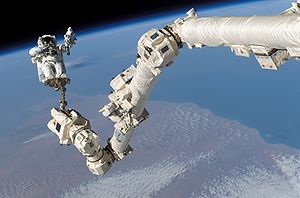 |
|
| Quest (Joint Airlock) | 7A | 2001-07-12 | (STS-104 STS-104 STS-104 was a Space Shuttle mission to the International Space Station flown by Space Shuttle Atlantis. Its primary objectives were to install the Quest Joint Airlock and help perform maintenance on the International Space Station... ) |
5.5 | 4 | 6,064 |  |
 |
| Pirs (Docking Compartment & Airlock) | 4R | 2001-09-14 | Soyuz-U Soyuz-U The Soyuz-U launch vehicle is an improved version of the original Soyuz LV. Soyuz-U is part of the R-7 family of rockets based on the R-7 Semyorka missile. Members of this rocket family were designed by the TsSKB design bureau and constructed at the Progress Factory in Samara, Russia.... (Progress M-SO1 Progress M-SO1 Progress M-SO1 was a modified Progress spacecraft used to deliver the Pirs module to the International Space Station. It was based on the Progress-M 11F615A55 spacecraft, with the pressurised cargo module removed to accommodate Pirs, and had the serial number 301.Progress M-SO1 was launched by a... ) |
4.91 | 2.55 | 3,580 |  |
 |
| S0 Truss | 8A | 2002-04-08 | (STS-110 STS-110 STS-110 was a Space Shuttle mission to the International Space Station on 8–19 April 2002 flown by Space Shuttle Atlantis. The main purpose was to install the S0 Truss segment, which forms the backbone of the truss structure on the station.- Crew :... ) |
13.4 | 4.6 | 13,970 |  |
|
| Mobile Base System | UF2 | 2002-06-05 | (STS-111 STS-111 STS-111 was a space shuttle mission to the International Space Station flown by Space Shuttle Endeavour. STS-111 resupplied the station and replaced the Expedition 4 crew with the Expedition 5 crew... ) |
5.7 | 2.9 | 1,450 |  |
 |
| S1 Truss | 9A | 2002-10-07 | (STS-112 STS-112 STS-112 was an 11-day space shuttle mission to the International Space Station flown by . Space Shuttle Atlantis was launched on 7 October 2002 at 19:45 UTC from the Kennedy Space Center's launch pad 39B to deliver the 28,000 pound Starboard 1 truss segment to the Space Station... ) |
13.7 | 4.6 | 14,120 | 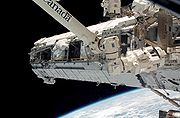 |
 |
| P1 Truss | 11A | 2002-11-23 | (STS-113 STS-113 STS-113 was a Space Shuttle mission to the International Space Station flown by Space Shuttle Endeavour. During the 14-day mission in late 2002, Endeavour and its crew extended the ISS backbone with the P1 truss and exchanged the Expedition 5 and Expedition 6 crews aboard the station... ) |
13.7 | 4.6 | 14,000 | 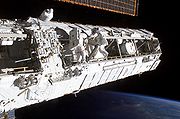 |
 |
| ESP External Stowage Platform External Stowage Platforms are key components of the International Space Station . Each ESP is an external pallet that can hold spare parts, also known as Orbital Replacement Units , for the space station. As a platform it is not pressurized, but does require electricity to power the heaters of... -2 |
LF1 | 2005-07-26 | (STS-114 STS-114 -Original crew:This mission was to carry the Expedition 7 crew to the ISS and bring home the Expedition 6 crew. The original crew was to be:-Mission highlights:... ) |
3.65 | 4.9 | 2,676 | 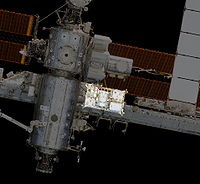 |
 |
| P3/P4 Truss & Solar Arrays | 12A | 2006-09-09 | (STS-115 STS-115 Note:The P3/P4 Truss segment and batteries were so heavy that the crew count was reduced from seven to six.-Crew notes:... ) |
13.8 | 4.9 | 15,900 | 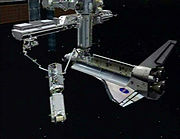 |
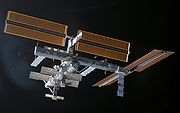 |
| P5 Truss | 12A.1 | 2006-12-09 | (STS-116 STS-116 -Crew notes:Originally this mission was to carry the Expedition 8 crew to the ISS. The original crew was to be:-Mission highlights:* The STS-116 mission delivered and attached the International Space Station's third port truss segment, the P5 truss.... ) |
3.4 | 4.6 | 1,818 | .jpg) |
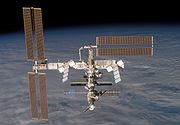 |
| S3/S4 Truss & Solar Arrays | 13A | 2007-06-08 | (STS-117 STS-117 - Crew Notes :The initial crew manifest before the Columbia accident was:Astronaut Mark Polansky was originally slated to pilot this mission, but was moved to STS-116, which he commanded... ) |
13.8 | 4.9 | 15,900 | 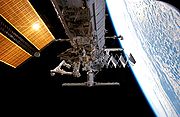 |
 |
| S5 Truss and ESP External Stowage Platform External Stowage Platforms are key components of the International Space Station . Each ESP is an external pallet that can hold spare parts, also known as Orbital Replacement Units , for the space station. As a platform it is not pressurized, but does require electricity to power the heaters of... -3 |
13A.1 | 2007-08-08 | (STS-118 STS-118 - Crew notes :Astronaut Clayton Anderson originally was slated to be launched to the ISS on this mission, but was moved to STS-117. His replacement was Alvin Drew.... ) |
13.7 | 3.9 | 12,598 | 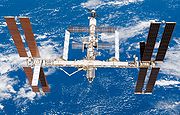 |
|
| Harmony (Node 2) Relocation of P6 Truss |
10A | 2007-10-23 | (STS-120 STS-120 -Crew notes:As commander of STS-120, Pamela Melroy became the second woman to command a space shuttle mission. Additionally, the Expedition 16 crew that received STS-120 was commanded by Peggy Whitson, the first female ISS commander... ) |
7.2 | 4.48 | 14,288 |  |
 |
| Columbus Columbus (ISS module) Columbus is a science laboratory that is part of the International Space Station and is the largest single contribution to the ISS made by the European Space Agency .... (European Laboratory) |
1E | 2008-02-07 | (STS-122 STS-122 STS-122 was a NASA Space Shuttle mission to the International Space Station , flown by the Space Shuttle Atlantis. STS-122 marked the 24th shuttle mission to the ISS, and the 121st space shuttle flight since STS-1.... ) |
7 | 4.5 | 12,800 |  |
 |
| Dextre (SPDM) Japanese Logistics Module Japanese Experiment Module The Japanese Experiment Module , also known with the nickname , is a Japanese science module for the International Space Station developed by JAXA. It is the largest single ISS module. The first two pieces of the module were launched on space shuttle missions STS-123 and STS-124... (ELM-PS) |
1J/A | 2008-03-11 | (STS-123 STS-123 -Mission parameters:* Mass:* Orbiter liftoff: * Orbiter landing: * Perigee: 336 kilometers * Apogee: 346 kilometers * Inclination: 51.6 degrees* Period: 91.6min-Mission payloads:... ) |
3.9 (ELM-PS) | 4.4 (ELM-PS) | 4,200 (ELM-PS) | 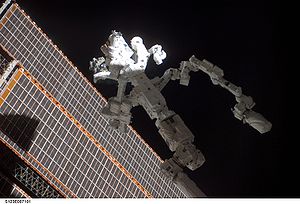 |
 |
| Japanese Pressurized Module Japanese Experiment Module The Japanese Experiment Module , also known with the nickname , is a Japanese science module for the International Space Station developed by JAXA. It is the largest single ISS module. The first two pieces of the module were launched on space shuttle missions STS-123 and STS-124... (JEM-PM) JEM Robotic Arm Japanese Experiment Module The Japanese Experiment Module , also known with the nickname , is a Japanese science module for the International Space Station developed by JAXA. It is the largest single ISS module. The first two pieces of the module were launched on space shuttle missions STS-123 and STS-124... (JEM-RMS) |
1J | 2008-05-31 | (STS-124 STS-124 STS-124 was a Space Shuttle mission, flown by Space Shuttle Discovery to the International Space Station. Discovery launched on 31 May 2008 at 17:02 EDT, moved from an earlier scheduled launch date of 25 May 2008, and landed safely at the Kennedy Space Center's Shuttle Landing Facility, at 11:15... ) |
11.2 (JEM-PM) | 4.4 (JEM-PM) | 15,900 (JEM-PM) |  |
 |
| S6 Truss & Solar Arrays | 15A | 2009-03-15 | (STS-119 STS-119 -Crew notes:This mission was originally scheduled to bring the Expedition 9 crew to the ISS. This crew would have consisted of:-Mission parameters:* Mass:* Orbiter liftoff: * Orbiter landing: * Perigee: * Apogee:... ) |
73.2 | 10.7 | 15,900 | .jpg) |
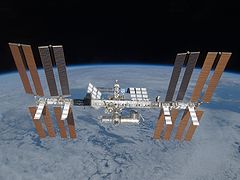 |
| Japanese Exposed Facility Japanese Experiment Module The Japanese Experiment Module , also known with the nickname , is a Japanese science module for the International Space Station developed by JAXA. It is the largest single ISS module. The first two pieces of the module were launched on space shuttle missions STS-123 and STS-124... (JEM-EF) |
2J/A | 2009-07-15 | (STS-127 STS-127 STS-127 was a NASA Space Shuttle mission to the International Space Station . It was the twenty-third flight of . The primary purpose of the STS-127 mission was to deliver and install the final two components of the Japanese Experiment Module: the Exposed Facility , and the Exposed Section of the... ) |
4,100 |  |
 |
||
| Poisk (MRM-2) | 5R | 2009-11-10 | Soyuz-U Soyuz-U The Soyuz-U launch vehicle is an improved version of the original Soyuz LV. Soyuz-U is part of the R-7 family of rockets based on the R-7 Semyorka missile. Members of this rocket family were designed by the TsSKB design bureau and constructed at the Progress Factory in Samara, Russia.... (Progress M-MIM2 Progress M-MIM2 Progress M-MIM2 , or Progress M-MRM2, originally designated Progress M-SO2, was a modified Progress-M spacecraft which was used to deliver the Poisk module to the International Space Station. It was based on the Progress-M 11F615A55 spacecraft, with the pressurised cargo module removed to... ) |
3670 | ||||
| ExPRESS Logistics Carriers 1 & 2 EXPRESS Logistics Carrier An ExPRESS logistics carrier is an unpressurized attached payload platform for the International Space Station that provides mechanical mounting surfaces, electrical power, and command and data handling services for Orbital Replacement Units as well as science experiments on the ISS... |
ULF3 | 2009-11-16 | (STS-129 STS-129 -Crew seat assignments:-Mission payload:-ExPRESS Logistics Carriers 1 and 2:The primary payload of STS-129 was the ExPRESS Logistics Carrier and the ELC-2. The mass capacity of each ELC is with a volume of 30 meters cubed... ) |
|||||
| Cupola & Tranquility (Node 3) |
20A | 2010-02-08 | (STS-130 STS-130 STS-130 was a NASA Space Shuttle mission to the International Space Station . 's primary payloads were the Tranquility module and the Cupola, a robotic control station with six windows around its sides and another in the center, providing a 360-degree view around the station... ) |
6.5 (Node 3) 1.5 (Cupola) |
4.25 (Node 3) 2.95 (Cupola) |
12,247 (Node 3) 1,800 (Cupola) |
||
| Rassvet Rassvet (ISS module) Rassvet , also known as the Mini-Research Module 1 and formerly known as the Docking Cargo Module , is a component of the International Space Station . The module's design is similar to the Mir Docking Module launched on STS-74 in 1995. Rassvet is primarily used for cargo storage and as a docking... (MRM-1) |
ULF4 | 2010-05-14 | (STS-132 STS-132 STS-132 was a NASA Space Shuttle mission, during which Space Shuttle Atlantis docked with the International Space Station on 16 May 2010. STS-132 was launched from the Kennedy Space Center on 14 May 2010. The primary payload was the Russian Rassvet Mini-Research Module, along with an Integrated... ) |
5075 | ||||
| Leonardo (PMM) and EXPRESS Logistics Carrier 4 EXPRESS Logistics Carrier An ExPRESS logistics carrier is an unpressurized attached payload platform for the International Space Station that provides mechanical mounting surfaces, electrical power, and command and data handling services for Orbital Replacement Units as well as science experiments on the ISS... |
ULF5 | 2011-02-24 | (STS-133 STS-133 STS-133 was the 133rd mission in NASA's Space Shuttle program; during the mission, Space Shuttle Discovery docked with the International Space Station. It was Discoverys 39th and final mission. The mission launched on 24 February 2011, and landed on 9 March 2011... ) |
|||||
| Alpha Magnetic Spectrometer Alpha Magnetic Spectrometer The Alpha Magnetic Spectrometer, also designated AMS-02, is a particle physics experiment module that is mounted on the International Space Station. It is designed to search for various types of unusual matter by measuring cosmic rays. Its experiments will help researchers study the formation of... , OBSS Orbiter Boom Sensor System The Orbiter Boom Sensor System is a 50-foot boom carried on board NASA's Space Shuttles. The boom can be grappled by the Canadarm and serves as an extension of the arm, doubling its length to a combined total of 100 feet... and EXPRESS Logistics Carrier 3 EXPRESS Logistics Carrier An ExPRESS logistics carrier is an unpressurized attached payload platform for the International Space Station that provides mechanical mounting surfaces, electrical power, and command and data handling services for Orbital Replacement Units as well as science experiments on the ISS... |
ULF6 | 2011-05-16 | (STS-134 STS-134 STS-134 was the penultimate mission of NASA's Space Shuttle program. The mission marked the 25th and final flight of . This flight delivered the Alpha Magnetic Spectrometer and an ExPRESS Logistics Carrier to the International Space Station. Mark Kelly served as the mission commander... ) |
6,731 (AMS-02) |  |
|||
| Nauka (MLM) European Robotic Arm European Robotic Arm The European Robotic Arm is a robotic arm to be attached to the Russian Segment of the International Space Station. It will be the first robot arm able to work on the Russian space station segments, and will supplement the two Russian Strela cargo cranes that are already installed on the Pirs... |
3R | 2012-05-?? (scheduled) | Proton-M Proton-M The Proton-M, GRAU index 8K82M or 8K82KM, is a Russian carrier rocket derived from the Soviet-developed Proton. It is built by Khrunichev, and launched from sites 81 and 200 at the Baikonur Cosmodrome in Kazakhstan. Commercial launches are marketed by International Launch Services , and generally... |
 |
Cancelled modules
- Interim Control ModuleInterim Control ModuleThe Interim Control Module is a NASA constructed module designed to serve as a temporary "tug" for the International Space Station in case the Zvezda service module was destroyed or not launched for an extended period of time. It was derived from a formerly-classified Titan Launch Dispenser used...
- not needed once Zvezda was launched (in storage ready to launch at short notice if required) - ISS Propulsion ModuleISS Propulsion ModuleThe ISS Propulsion module was proposed as a backup to functions performed by the Zvezda Service Module and Progress spacecraft. Critical ISS functionality such as guidance, navigation, control and propulsion are provided only by Russian and future European assets...
- not needed once Zvezda was launched - Habitation ModuleHabitation Modulethumb|right|250px|ISS Habitation moduleThe Habitation Module for the International Space Station was intended to be the Station's main living quarters designed with galley, toilet, shower, sleep stations and medical facilities. About the size of a bus, the module was canceled after its pressurized...
(HAB) - With the cancellation of the Habitation Module, sleeping places are now spread throughout the station. There are two in the Russian segment and four in the US segment. It is not necessary to have a separate 'bunk' in space — many visitors just strap their sleeping bag to the wall of a module, get into it and sleep. - Crew Return Vehicle (CRV)Crew Return VehicleThe Crew Return Vehicle , sometimes referred to as the Assured Crew Return Vehicle , is the proposed lifeboat or escape module for the International Space Station...
- replaced by two Soyuz crafts - Centrifuge Accommodations ModuleCentrifuge Accommodations ModuleThe Centrifuge Accommodations Module is a cancelled element of the International Space Station. Although the module was planned to contain more than the a centrifuge, the centrifuge still was considered the most important capability of the module...
(CAM) - would have been attached to Harmony (Node 2) - Science Power PlatformScience Power PlatformThe Science Power Platform was a planned Russian element of the International Space Station that was intended to be delivered to the ISS by a Russian Proton rocket or Zenit rocket but was shifted to launch by Space Shuttle as part as a tradeoff agreement on other parts of the ISS...
(SPP) - power will be provided to the Russian segments partly by the US solar cell platforms - Russian Research ModuleRussian Research ModuleThe Russian Research Module was to be a Russian component of the International Space Station that provided facilities for Russian science experiments and research...
s (RM1 and RM2) - to be replaced by single Multipurpose Laboratory ModuleMultipurpose Laboratory ModuleNauka , also known as the Multipurpose Laboratory Module , , will be a component of the International Space Station , funded by the Russian Federal Space Agency. In the original ISS plans, Nauka was to use the location of the Docking and Stowage Module...
(Nauka) - Universal Docking ModuleUniversal Docking ModuleThe Nodal Module is a pressurized module of the Russian Segment of the International Space Station and will be used in the OPSEK space station...
(UDM) - canceled along with the Research Modules which were to connect to it
Proposed modules
The following modules are proposed, but not yet confirmed in the ISS launch manifests.- Russian Nodal Module - UDM with proposed launch in 2013
- Russian Science-Power Module-1 - combination of RM1 and parts of SPP with proposed launch in 2014
- Russian Science-Power Module-2 - combination of RM2 and parts of SPP with proposed launch in 2015
- American Node 4Node 4Node 4, also known as the Docking Hub System , is a proposed module of the International Space Station . NASA is considering a 40-month design and development effort for Node 4 that would result in its launch in late 2013....
- Also known as the Docking Hub System (DHS), would allow the station to have more docking ports for visiting vehicles and would allow inflatable habitats and technology demonstrations to be tested as part of the station. - Bigelow AerospaceBigelow AerospaceBigelow Aerospace is a North Las Vegas, Nevada space technology startup company that is pioneering work on expandable space station modules. Bigelow Aerospace was founded by Robert Bigelow in 1998...
inflatable module - Also known as the Bigelow Expandable Activity Module, or BEAM, for the ISS. Proposed for post-2013 launched atop an Expendable Launch Vehicle. The Bigelow inflatable module would be berthed to Node 3 or the currently unfunded Node 4. - Nautilus-X Centrifuge Demonstration - If produced, this centrifuge will be the first in-space demonstration of sufficient scale centrifuge for artificial partial-g effects. It will be designed to become a sleep module for the ISS crew.
Formerly proposed and later abandoned modules:
- Russian Commercial Enterprise Module entertainment and studio module.
See also
For the full list of ISS flights see the List of unmanned spaceflights to the ISS and List of human spaceflights to the ISSExternal links
- Animated ISS assembly process, mission designations and dates are included.
- Diagram of planned components of the ISS, positions of cancelled modules can be seen.
Media articles

